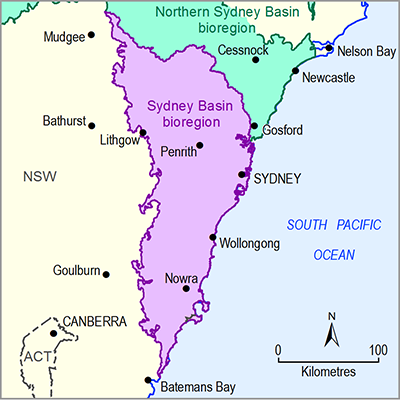- Home
- Assessments
- Bioregional Assessment Program
- Sydney Basin bioregion
- 1.1 Context statement for the Sydney Basin bioregion
- 1.1.6 Surface water – groundwater interactions
- 1.1.6.2 Effects of mining on interactions with water courses
Studies of water courses near surface and underground mining operations are often hampered by a lack of pre-mining data collection. However, Jankowski (2007, 2009) has identified some general characteristics of systems in the Sydney Basin bioregion subject to mining disturbance. In an undisturbed state, groundwater flow is typically toward the stream as baseflow to a connected-gaining stream via an alluvial aquifer and the stream bed. Discharge supporting streamflow is often from springs, with local artesian head, or direct streambed connection in an area of significant vertical faulting. During mining operations there may be a reduction in the hydraulic gradient toward the stream but it remains a connected-gaining stream with reduced discharge. If there is sufficient dewatering of a surface mine, a reversal of the hydraulic gradient may result that causes the stream to become a connected-losing stream, meaning there is no longer any baseflow discharge and that runoff in the stream is lost. The impacts of a longwall mining operation can include changes to the strength and direction of the local groundwater gradient to the stream and associated streamflow changes. Structural changes that increase fracturing of streambed contact rocks can impact the wider catchment, with a reduction in surface flow to the stream, and increased losses through the streambed via new or expanded fracture zones. Where losses are so great that the groundwater table no longer intersects the streambed, the stream becomes a disconnected-losing stream.
Madden and Merrick (2009) summarised longwall mining effects as ‘The impact on groundwater systems from longwall mining is attributed to subsidence, strata movements and drainage.’ The first two of these are mechanisms that create new, or distort existing, groundwater pathways that tend to increase drainage away from surface features and reduce groundwater heads. The third mechanism involves drainage of water into underground mining voids. Water quality changes can occur whenever water from different layers is allowed to mix or drain due to new or altered flow paths.
Structural alterations from mining operations increase the complexity of the flow paths controlling surface water – groundwater interactions. Further, they almost exclusively result in decreased flow in creeks and potentially less groundwater discharge to other creeks in the immediate surface water catchment. It is not known how much losses of localised stream and creek flow are translated into river discharge in the intermediate and regional settings, but they must be considered as potentially impacting streamflow downstream from mining operations, at least within a reach down to a major storage reservoir. For example, Hawkes and Ross (2008) found that pumping alone in a 60-day test of the Hawkesbury Sandstone at Leonay, western Sydney, did not influence shallow monitoring bores in the surficial Cranebrook Formation. This suggests that unless connectivity is pre-existing, or is generated by anthropogenic or natural forces, local and regional groundwater are not always locally connected.
The Reynolds Inquiry (1976) found that bord and pillar mining under reservoirs at a minimum depth of suitable cover of 60m is unlikely to cause sufficient disturbance of the strata to increase any existing seepage from reservoirs. Subsequent investigations, including those involving longwall mining operations, have not updated the minimum depth of suitable cover, instead reporting continued uncertainty around the potential impact of subsidence upon surface water features including rivers and significant streams (McNally and Evans, 2007; NSWDP Southern Coalfields Enquiry, 2008).

